THE
BILL OF RIGHTS: PART I
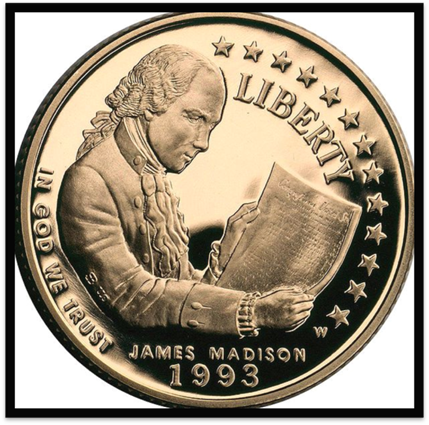
James Madison and the Bill of
Rights: Commemorative Coin
Unit Overview
As the U.S. Constitution was being debated and
ratified, the Anti-federalists argued for stronger protection of individual
rights and specific limits on the national government’s authority. The Constitution soon included ten
amendments, known as the Bill of Rights, to address these concerns. Today, they, too, are part of a living
document which continues to be defined and interpreted by judicial decisions,
legislation and other practices.
Americans still analyze and evaluate the freedoms of speech, religion,
press, assembly and petition on a daily basis.
However, these civil liberties are balanced by the obligation to respect
the rights of others.
![]()
The Constitution and the Rights of
Individuals
During the struggle for ratification of the
Constitution, Americans disagreed on a variety of political concepts and
principles, but the lack of a bill of rights caused the greatest
controversy. The Federalists, who
supported the adoption of the Constitution as it had been drafted by the
Constitutional Convention, insisted that most states had included detailed
bills of rights in their individual plans for government. They also argued that, in Article I: Section 9, the Constitution does ban certain
laws that violate the rights of individuals.
These include bills of attainder and ex post facto laws. Writs of habeas corpus can only be denied
under extreme circumstances.
Ø Bills of Attainder: A bill of attainder refers to an act of
Congress that singles out a group or individual and assigns a punishment
without a trial. Since the Founding
Fathers knew that legislation like this had been used by European rulers to
confiscate the property of prisoners, both Congress and state legislatures are
prohibited from passing this type of law.
Bills of attainder are rare in American history, but the Test Oath Act,
passed in 1865, is one example. The Test
Oath Act kept lawyers, who had been Confederate soldiers, from pleading cases
in federal courts. Since it singled out
a specific group and revoked privileges without a trial, the law was declared
unconstitutional in 1867.
Ø Ex Post Facto Laws: Ex post facto laws are also forbidden by the
Constitution. These laws, named from a
Latin phrase meaning “after the deed or the action,” are designed to punish
people for activities that were not illegal when they were performed. For example, if a state lowers the speed
limit on its highways, it cannot issue citations to those who were exceeding
that limit before the law was passed.
Ø Writs of Habeas Corpus: Section 9 of Article I also addresses writs
of habeas corpus. The term is derived
from a Latin phrase meaning “you have the body.” The body, in this instance, means collection
of evidence or valid reasons. When a
prisoner is held by the federal government, he/she can request a writ of habeas
corpus. Then, it is the government’s
obligation to bring the prisoner to court and to show that the arrest was made
for specific reasons. However, the
Constitution notes that these writs can be suspended if a case involves a
rebellion or an invasion that threatens public safety. President Lincoln chose this course of action
during the Civil War, and President George W. Bush also denied these writs
during the Global War on Terror. In both
situations, these presidential decisions aroused criticism and controversy.
On the other hand, many Anti-federalists did not
believe that these safeguards were sufficient.
They saw the lack of a bill of rights as a critical flaw and refused to
support the adoption of the Constitution.
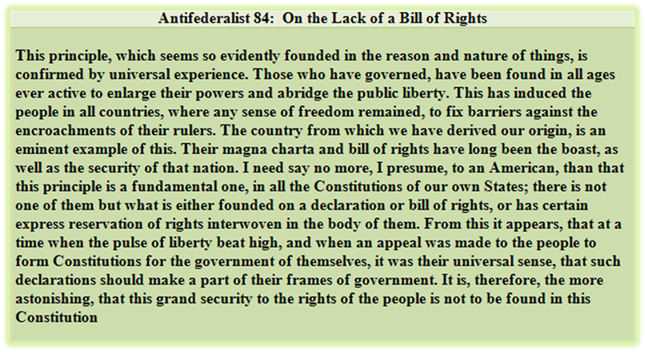
The debate over these issues became so intense that
several noted Federalists, such as George Washington and James Madison, agreed
to support the addition of a bill of rights once the Constitution was ratified.
Shortly after the Constitution was adopted, Congress sent proposals for twelve
amendments to the states. Ten, now known
as the Bill of Rights, were approved and were added to the Constitution in
1791. Originally, the purpose of the
first ten amendments was to protect the rights of citizens living under a
strong, national government. However,
throughout American history, the Bill of Rights has also been used to define
the principle of limited government and to ensure that state governments do not
violate basic civil rights.
![]() Go to Questions 1-5.
Go to Questions 1-5.
The First Amendment and Individual
Freedoms
The First Amendment lists five of the most important
civil liberties enjoyed by Americans. They
include the freedoms of religion, speech, press, petition and assembly.

Freedom of Religion
The First Amendment presents two facets of freedom
of religion. First, in what is called
the establishment clause, the
government is prohibited from requiring or supporting a specific religion. Since most European countries had one
official religious institution, which people were forced to support, the
Founding Fathers understood that this policy could result in discrimination and
persecution. Thomas Jefferson referred
to this clause in the Constitution as a “wall of separation” between the church
and the state. Questions concerning the
meaning of the establishment clause have triggered a number of cases before the
Supreme Court. Many of these have
involved schools and religion. For
example, the principal of Nathan Bishop Middle School asked a rabbi to speak at
a graduation ceremony. It was a common
practice in the area to invite clergy for benedictions and invocations at
school-related functions. A parent of
one of the students at the middle school took the matter to court on the
grounds that it violated the establishment clause in the First Amendment. In 1991, the Supreme Court heard the case of Lee v. Weisman and ruled that clergy who
offer prayers in public school ceremonies are in violation of the
Constitution. To hear about this case
from the point of view of the Weisman family, click on the picture below.
The second aspect of freedom of religion addressed
in the First Amendment is derived from the words “…or prohibiting the free
exercise thereof”. This phrase, called
the free exercise clause, guarantees
Americans the right to practice whatever religion they choose without
government interference. Sometimes,
however, religious practices and rituals may conflict with public safety and
health. In these situations, the
government can apply certain restrictions without violating the
Constitution. The Supreme Court has made
a number of rulings that define the right of worshipping freely or not
worshipping at all. Thomas v. Review Board of the Indiana Employment Security Division
is one such case. In 1980, the Blaw-Knox Foundry & Machinery Co. shifted operations in
one of its plants to the manufacture of weapons. Because his faith prevented him from
producing arms, Eddie Thomas, an employee, asked to be laid off. The request was granted, and he applied for
unemployment benefits. Since it did not
believe that his reasoning was justified, the Indiana Employment Security Division
denied his claim; then, Thomas filed a lawsuit based on the free exercise clause. In 1989, the Supreme Court heard the case and
ruled that the state of Indiana had violated Thomas’ First Amendment rights.
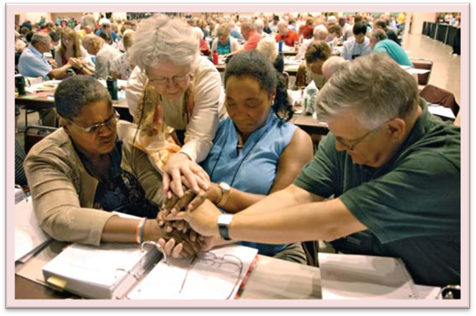
Evangelical Lutheran Churchwide
Assembly
Freedom of Speech
Freedom of speech has long been considered the
cornerstone of American democracy. For
citizens to be informed and to participate in the decision-making process, they
need to hear and to discuss a variety of opinions. The concept of speech has expanded over the
years to include many forms of expression, such as films, television
broadcasts, books and telephone conversations.
Social media and email are also under this broad umbrella. Even though freedom of speech is protected by
the Constitution, it does have limits.
Exactly what these limits are is continuously being defined by the
courts. Judges must sometimes balance
free speech against national security and public safety. Types of expression that the Supreme Court
has ruled not protected in most situations by the First Amendment include the
following:
Ø Causing panic: During World War I, Charles Schenck mailed distributed a large number of flyers
criticizing the use of the military draft.
This resulted in his arrest. He
believed that his First Amendment rights had been violated and filed a
lawsuit. When his case reached the
Supreme Court, the justices ruled that his conviction did not violate the
Constitution. When he wrote the majority
opinion for this case, Chief Justice Oliver Wendell Holmes stated the
following: “The most stringent
protection of free speech would not protect a man in falsely shouting ‘Fire!’
in a theater and causing a panic.” This
established the principle of weighing free speech against public safety.
Ø
Obscenity: The idea of obscenity is one of the most
controversial aspects of the First Amendment.
Since what is obscene to one person may not be obscene to another, it
represents a continuous challenge to the court system. When writing the majority opinion in the case
of Miller v California, Chief Justice
Warren Burger established a list of guidelines, known as the Miller Test; it is
still being used to decide what questionable material is protected as free
speech. Social media and technological
innovations continue to create new concerns requiring the court’s
interpretation of the First Amendment.
Ø
Defamation: Defamation is a basic term for attacks on
another person’s name, character or reputation.
If it is in spoken form, such as a public speech or a radio address,
this type of defamation is called slander. When it appears as written remarks in
newspapers or other printed media, it is known as libel. However, valid
criticism of politicians and celebrities is considered an appropriate use of
free speech. The landmark decision in
the case of New York Times v. Sullivan
(1964) emphasized this point. A civil
rights group paid the New York Times
to print an advertisement concerning the actions of the police department in
Montgomery, Alabama. L.B. Sullivan, the
police commissioner, sued the newspaper on the grounds that he had been
libeled. When the case reached the
Supreme Court, the justices decided in favor of the New York Times, but they also noted that the First Amendment does
not cover statements made with “actual malice” or “reckless disregard for the
truth”.
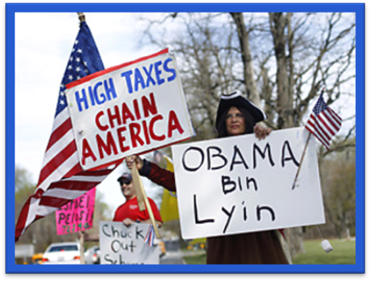
Freedom of Speech
Ø Fighting words: Fighting words are those expressions that,
when spoken, inflict injury and destroy the peace. To a degree, they are protected by the First
Amendment. If the danger to the public
is “clear” and “imminent”, law enforcement can limit the right of free
speech. Brandenburg v Ohio makes this point. Charles Brandenburg was a Ku Klux Klan
leader, who staged a rally in Ohio. He
refused to follow a police order to clear the street, and Brandenburg was
arrested. When his case reached the
Supreme Court, his right to free speech was upheld because there was no immediate
danger that the crowd would riot.
Ø Sedition: Sedition refers to words that are used to
incite rebellion or to promote the overthrow of the government. Espionage, treason, and sabotage are all
forms of seditious speech, but the meaning of these terms has also been defined
by a number of court decisions. In the
1950s, Oleta Yates and other members of the Communist
Party were convicted of advocating the overthrow of the United States
government. After a number of appeals,
the case reached the Supreme Court in 1957.
When the justices ruled in favor of Yates, they noted the difference
between speech that expresses a theory or an idea and speech that encourages
others to break the law. Discussions
concerning ideas and theories are protected under the First Amendment;
organizing a revolution or a riot is not.
Freedom of the Press
Americans consider freedom of the press to be an
important component of a democratic society.
Articles from printed and electronic sources foster constructive debate, encourage investigative reporting and present
different points of view. They can also
threaten national security, promote obscenity and make false statements in the
name of advertising. Along with the
power to inform, the press also has the power to distort. As a result, judicial rulings have expanded
freedom of the press in some areas and limited it in others. The case of New York Times Co. v. United States is one example. The New York Times and the Washington Post
received copies of a classified report known as the Pentagon Papers from Daniel
Ellsburg, a government employee. When the newspapers began to publish these
documents, the Nixon administration tried to stop them by filing a
lawsuit. The Supreme Court ruled on the
case in 1971 and upheld the publishing company’s right to print the Pentagon
Papers under the First Amendment. The
majority opinion noted that the government failed to prove a genuine threat to
national security.
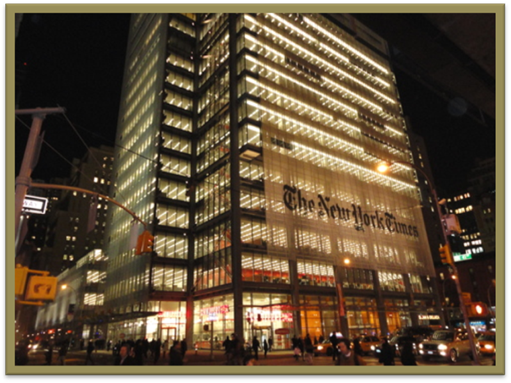
New York Times Offices:
Photo Credit--Jleon
Conflicts between the government and the press have
also developed over revealing the sources for news stories. Reporters insist that naming their informants
or forcing them to testify in court is an unfair limitation on a free
press. The Supreme Court, on the other
hand, has not extended the First Amendment to cover the sources of
journalists. In 1972, Earl Caldwell, a
reporter for the New York Times,
refused to give testimony before a federal grand jury about the operations of a
radical political group, the Black Panthers.
He asserted that a court appearance would end his access to certain
confidential sources. The Supreme Court
ruled that criminal investigations override a reporter’s right to
confidentiality. Some states have passed
laws that name conditions under which a reporter may not be required to testify
in state courts. These are called shield laws; however, they do not apply
in federal cases.
Freedoms of Petition and Assembly
The last section of the First Amendment addresses
the right to assemble and to petition.
Freedom of assembly includes participation in marches, parades, protests
and picket lines. The Constitution specifies
that these must be peaceful gatherings.
Like all the freedoms addressed in the First Amendment, the right to
assemble is limited by concerns for the public safety. For example, protestors are not permitted to
disrupt rush hour traffic or to obstruct airport runways. Participants do not have the right to loot
stores, to start fires or to take over public offices. Sometimes it is not the protestors who are
disorderly, but the bystanders. Hecklers
disturb the scene by shouting insults or by interfering with the
demonstrators. In these instances, law
enforcement may put a stop to the assembly for the sake of public safety. Generally, people can legally assemble in
areas supported by tax dollars. Parks,
sidewalks, state capitol grounds and national monuments have served as sites
for demonstrations. Court rulings have
restricted the public venues that may be used for this purpose. Harriet Louise Adderly
and a group of thirty-one other students from Florida A & M University
conducted a protest inside a local jail without permission. The sheriff asked them to leave, and the
group refused. The students were
arrested and were charged with trespassing.
When their case (Adderly v. Florida) came before the Supreme
Court in 1966, their convictions were upheld.
The majority opinion explained that, even though jails are public
institutions, they are built for security reasons and inappropriate for
protests.
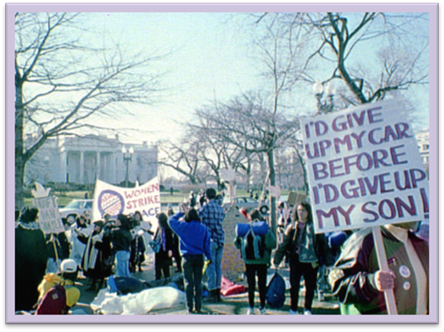
Freedom of Assembly
Unlike the other provisions of the First Amendment,
very few court cases have interpreted the right to petition. It is simply a way to encourage or to
disapprove of a government action.
Lobbying, letter-writing, e-mailing and collecting signatures are all
acceptable means to exercise the freedom of petition. Although this right is
often taken for granted, the process of petitioning helps to ensure that
leaders listen to the people, even when they would prefer to do otherwise.
![]() Go to Questions 6-14.
Go to Questions 6-14.
The Second Amendment and the Right to
Bear Arms
When congressmen first prepared to send a list of
proposed amendments to the states, the Revolutionary War and British tyranny
were fresh in their minds. The Second
Amendment, based on the language of the Anti-federalist arguments, limited the
power of the federal government by addressing the necessity of state militias
and the right to bear arms.
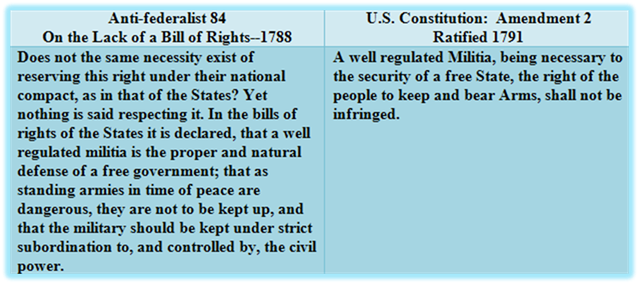
Does this amendment simply acknowledge the idea that
the federal government cannot outlaw state militias, or does it mean that, in
the tradition of the minutemen, every citizen is part of the militia and has a
right to bear arms? For the most part,
the courts have upheld that this privilege applies to individuals, but the
Supreme Court’s ruling in the case of the United
States v. Miller (1939) supported the right of Congress to pass gun control
legislation. The Second Amendment
continues to be controversial as Americans debate the impact of assault
weapons, mandatory background checks and the availability of ammunition.
![]() Go to Questions 15 and 16.
Go to Questions 15 and 16.
The Third Amendment and the Quartering
of Soldiers
Before the American Revolution, the British demanded
that their soldiers be housed and fed in the homes of the colonists. Since there were few inns and little time to
build barracks, this seemed to be a practical solution. However, the colonists deeply resented this
invasion of their privacy and the additional household expense. Many citizens of the new country believed their
property needed to be safeguarded. The
Third Amendment promises that United States citizens will not be forced to keep
soldiers in their homes during peacetime without their consent. It also, along with the Second Amendment,
reinforces the principle of limited government.

What’s
Next?
The amendments discussed in this unit consider the
personal rights of individuals and offer protection from government
interference. They are intended to
provide the necessary freedom of self-expression to the people they serve, but
they are not without limitations and restrictions. The rights guaranteed by the First Amendment
are not absolute; they must be balanced with respect for the rights of others. The Anti-federalists believed that citizens
needed protection from unwarranted searches, unwanted invasions of their
property and unfair treatment of accused persons in court. These things are also covered in the Bill of
Rights. Can the government take private
property for public use? Can you be
tried twice for the same crime? Does the
accused have the right to confront those who witness against him? We will consider all of these issues in the
next unit. Before continuing, review the
terms found in throughout this unit and complete Questions 17 through 26.
![]() Go to Questions 17-26.
Go to Questions 17-26.

Below are additional educational resources and activities for this unit.
